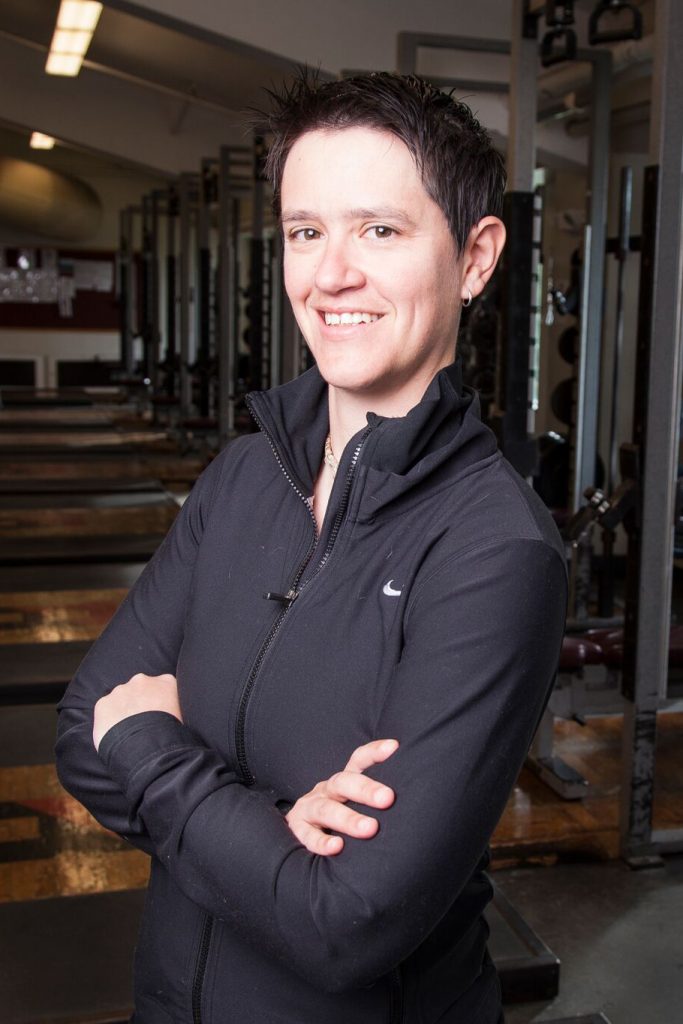I had a busy weekend moving and our new apartment currently looks like a HAZMAT scene. My hands are full figuring out where to put my Blu-Ray collection and fancy towels. Luckily my good friend and fellow coach, Kim Lloyd, was kind enough to pinch-write for me today.
How good of a listener are you when you’re coaching?

I came into this industry later than most. I quit my job to do an internship at Cressey Sports Performance when I was 38 years old – older than all of the coaches at CSP and most of the clients.
Note From TG: ahem, not older than all the coaches.
I spent the bulk of my internship and even my first few months as a coach stressing about how much I didn’t yet know. Periodization, how to do a half-kneeling 1-arm manual resistance with external rotation at 90 degrees, valsalva breathing (wasn’t the valsalva that hangy ball thing in your throat?)…the list went on and on.
As I was busy cramming my brain with the ins and outs of exercise physiology, it became easy to lose track of what coaching is really all about.
Listening.
It isn’t what you say to your client. It’s what your client is willing to say to you. Yes knowledge is important. But that whole business about two ears and one mouth and using them in that order?
That’s coaching.
Sure you have to know anatomy and exercises in order to help clients, but the knowledge does nothing if you can’t get to the heart of what motivates them and what’s important to them.
Listening by itself isn’t an easy skill.
Every morning on my drive in to work I either listen to a podcast or an Audible book (although somedays it’s Whitney Houston, because you know, Whitney Houston.) And without fail, at some point during my 50 minute commute, I’m reaching to hit the 10 or 30 second rewind button because I zoned out.
Recent research suggests that humans now really do have the attention span of a goldfish. According to a 2015 study from the Microsoft Corporation, people now lose concentration after eight seconds, where the goldfish can actually concentrate for nine seconds. Back in 2000, we could concentrate for a whopping 12 seconds. But not any more.
Note From TG: Unless you’re a twelve year old kid.1 I give you exhibit A:
So what does that mean for us as coaches?
We all fall into the trap of constantly “nexting,” as author Daniel Goleman reminds us in the book Primal Leadership. I know I often catch myself in a conversation with a client waiting to talk as opposed to actively listening. She just said something that reminds me of a great post I read about core training and I know exactly what she needs to do.

If she would only stop talking so I could fix it.
Actively listening means responding to the client in a way that makes her feel understood. That sounds easy, but training ourselves to stop, pay attention, and be present with someone is as much a matter of practice and conditioning as any exercise set we assign. I’ve found that the following tips help:
1) Maintain Eye Contact
No, not in a creepy, bug eyed way.
In a way that is absorbing the entirety of what’s being said. You’re looking at the client and watching her facial expressions and nodding when it’s appropriate. Our clients need to know we’re listening.
This can be tough to do if a client decides to divulge some important information to you while you’re in the middle of a session with three other people, but in this case, I try to schedule another time to talk. Hey, you’ve got some important stuff to say and I want to give you my full attention, so let’s talk about this after the session.
2) Don’t Interrupt
Have you ever tried to tell a story and had someone finish your sentence for you? But not in a cute, we’ve-been-married-for-fifty-years kind of way. More in a what-the-hell-I-was-just-pausing-to-breathe-it’s-not-an-invitation kind of way.

Stop doing that. No really. Cut it out.
Listen to the whole sentence. And then listen to the next whole sentence. And wait until there’s more than a 0.5 second break to start talking. In fact, wait several seconds. Make sure you’ve heard her. Reflect what she’s told you to make sure you understand.
3) Don’t Give Advice
This is a tough one and is the staple of motivational interviewing. You’re not so much solving the problem for a client as helping them solve it themselves. You can guide the process, but telling people what to do isn’t the same as having them come up with the solution on their own. To help them get to that solution, you have to be paying attention to the information they give you, and absorbing enough to point out connections they may not have initially recognized.
4) Empathize
Some coaches are naturally empathetic. And some are guys.
Note From TG: ohhhhhhhhhhhhhhhhhhhhhh2, snap.
Just kidding guys, just kidding.
Empathy comes naturally to many of us in this industry – it’s why, hopefully, we are in the business of helping others. According to Brene Brown, who did all kinds of research on vulnerability and empathy, the very definition of empathy is “feeling with people.”
Rarely does an empathetic response start with the phrase “At least.”
“I just had shoulder surgery.”
“At least you have one good arm.”
Um, yup. Thanks for that. Makes my spending six weeks in a sling and six months doing rehab completely better.
Good coaching has many components, and we are all working tirelessly to figure out what those pieces are. But I know for me as a client or a patient, the most satisfying and important criteria in choosing who I’ll work with is a feeling that I’ve been heard. That you are not just nodding and smiling and waiting for your turn to talk.
And I believe all of our clients want the same.
Author’s Bio
 Spurling Fitness in Kennebunk, Maine. Prior to working in the fitness industry Kim worked in college athletics as a softball, lacrosse, and cross country coach. She has a Masters in Sports Leadership from Northeastern University and is a proud graduate of Gannon University in Erie, Pennsylvania.
Spurling Fitness in Kennebunk, Maine. Prior to working in the fitness industry Kim worked in college athletics as a softball, lacrosse, and cross country coach. She has a Masters in Sports Leadership from Northeastern University and is a proud graduate of Gannon University in Erie, Pennsylvania.


